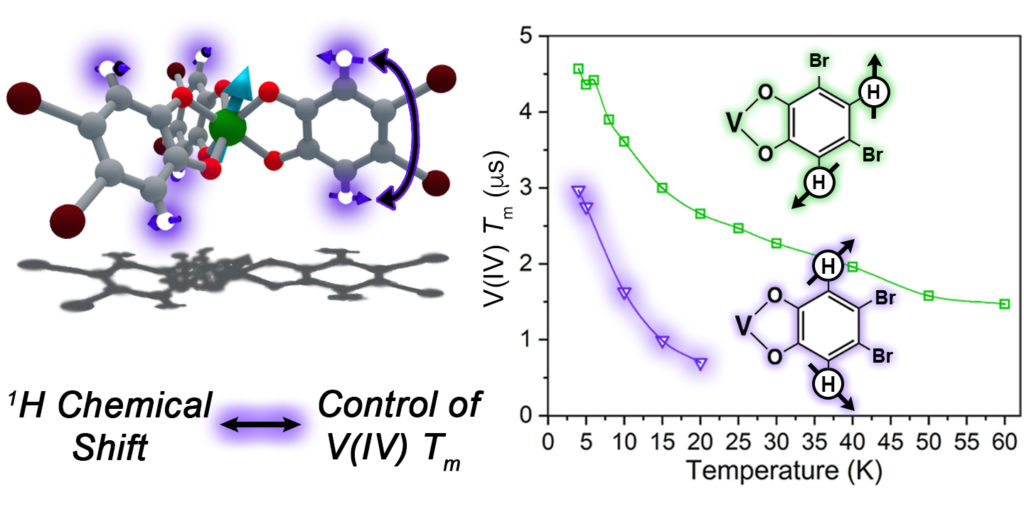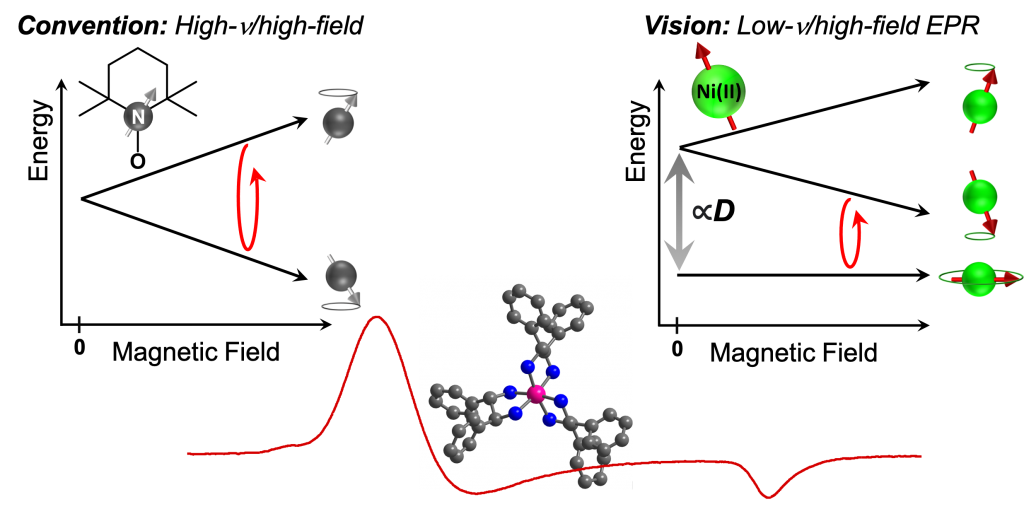Research

Electronic and nuclear magnetic moments (spins) are present in nearly all matter. Our group is fundamentally interested in how to tune the properties of these spin systems in molecules and materials via the chemist’s toolkit: synthesis. Our goal is to use synthesis for the development of structure-property relationships. To achieve these goals, we must (1) prepare novel materials/molecules, which we do using Schlenk lines or one of our two glove boxes, and (2) thoroughly characterize prepared substances, applying an extensive array of spectroscopic and physical techniques. We leverage this fundamental science to develop solutions to pressing technological challenges, such as MRI detection of disease, discovery of new reactivity paradigms, and the design of transformative materials. Two recently-published projects are summarized below – check out our publications for more information about our chemistry!
The Molecular Edge of the Spin Bath

Understanding what governs magnetic relaxation times is an essential challenge in controlling metal-ion magnetism. We are working to understand how magnetic species that immediately neighbor a metal ion (the “edge” of the spin bath) influence the ion’s magnetic properties. In one area of this work, a series of substitutionally patterned ligands was created to investigate the role of so-called “nuclear spin patterns” on relaxation .
Johnson, S. H.; Jackson, C. E.; Zadrozny, J. M. “Programmable Nuclear Spin Dynamics in Ti(IV) Coordination Complexes” Inorg. Chem. 2020, 59, 7479-7486. DOI: 10.1021/acs.inorgchem.0c00244
Jackson, C. E.; Lin, C.-Y.; Johnson, S. H.; van Tol, J.; Zadrozny, J. M. “Nuclear-Spin-Pattern Control of Electron-Spin Dynamics in a Series of V(IV) Complexes” Chem. Sci. 2019, 10, 8447-8454. DOI: 10.1039/C9SC02899D
Lin, C.-Y.; Ngendahimana, T.; Eaton, G. R.; Eaton, S. S.; Zadrozny, J. M. “Counterion Influence on Dynamic Spin Properties in a V(IV) Complex” Chem. Sci. 2019, 10, 548-555. DOI: 10.1039/C8SC04122A
Magnetic Thermometry

Current magnetic resonance imaging (MRI) technology only images tissue. However, measuring local temperature within the body noninvasively would be a powerful diagnostic tool. Sensing temperature by MRI requires temperature-sensitive nuclear spin properties. Cobalt-59 NMR was used to investigate the effect of increasingly rigid ligand frameworks around a Co(III) nucleus.
Üngör, Ö.; Ozvat, T. M.; Ni, Z.; Zadrozny, J. M. “Record Chemical-Shift Temperature Sensitivity in a Series of Trinuclear Cobalt Complexes” J. Am. Chem. Soc. 2022, Accepted article.
Ozvat, T. M.; Peña, M. E.; Zadrozny, J. M. “Influence of Ligand Encapsulation on Cobalt-59 Chemical-Shift Thermometry” Chem. Sci. 2019, 10, 6727-6734. DOI: 10.1039/C9SC01689A
Ozvat, T. M.; Rappé, A. K.; Zadrozny, J. M. “Isotopomeric Elucidation of the Mechanism of Temperature Sensitivity in 59Co-NMR Molecular Thermometers” Inorg. Chem. 2022, 61, 778-785. DOI: 10.1021/acs.inorgchem.1c03326.
Metal-Ion EPR Imaging Probes

Electron paramagnetic resonance imaging (EPRI) is a cutting edge biomedical imaging technique that can give detailed information on local chemical environment. We are developing metal-based molecular imaging probes that operate at low microwave frequencies. Towards this goal, we are exploring how features of molecular geometry, ligand identity, and electronic structure impact low-frequency EPR spectral properties.
Campanella, A. J.; Nguyen, M.-T.; Zhang, J.; Ngendahimana, T.; Antholine, W. E.; Eaton, G. R.; Eaton, S. S.; Glezakou, V.-A.; Zadrozny, J. M. “Ligand Control of Low-Frequency Electron Paramagnetic Resonance Linewidth in Cr(III) Complexes” Dalton Trans. 2021, 50, 5342-5350. DOI: 10.1039/D1DT00066G.
Campanella, A. J.; Ozvat, T. M.; Zadrozny, J. M. “Ligand Design of Zero-Field Splitting in Trigonal Prismatic Ni(II) Cage Complexes” Dalton Trans. 2022, 51, 3341-3348. DOI:10.1039/D1DT02156G